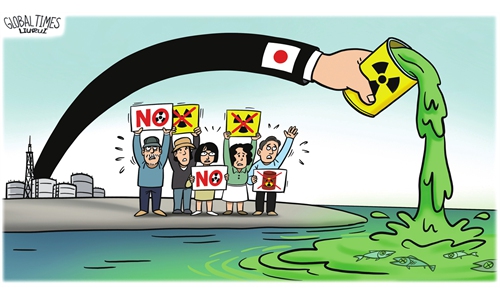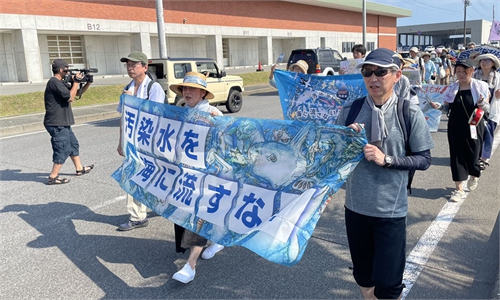Take Fukushima nuclear-contaminated wastewater dumping case to the UN General Assembly
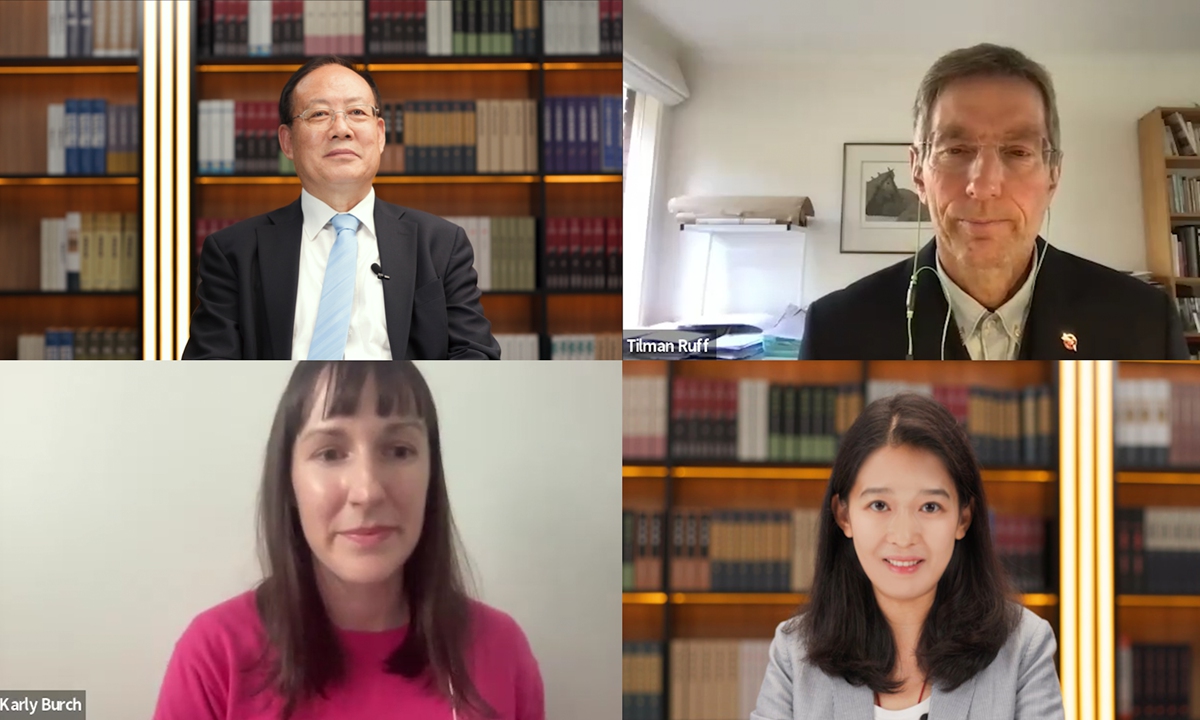
Gao Zhiguo (top left), Tilman Ruff, Li Aixin and Karly Burch (clockwise) Photo: Screenshot
Editor's Note:
As early as August, the release of nuclear-contaminated wastewater from Fukushima Daiichi nuclear power plant will begin, according to media reports. Japan is proceeding with the plan despite ongoing opposition, anxiety and anger both at home and abroad. What are the potential risks we are about to face? What else can we do to protect ourselves and our planet from nuclear pollution? Gao Zhiguo (Gao), president of the Chinese Society of the Law of the Sea and former judge of the International Tribunal for the Law of the Sea, Tilman Ruff (Ruff), Board member and previous cp-president of International Physicians for the Prevention of Nuclear War (Nobel Peace Laureate 1985) and co-founder and founding international and Australian chair of the International Campaign to Abolish Nuclear Weapons (Nobel Peace Laureate 2017), and Karly Burch (Burch), a sociology lecturer from the University of Auckland, shared their views with reporter Li Aixin at the Global Times' Global Minds Roundtable (GT).
GT: There have been discussions on the insufficiency of the Advanced Liquid Processing System (ALPS) method as it does not treat certain radioactive elements. If discharged, this contaminated water can move up in the food chain. Specifically, how could humans be affected?
Ruff: The concern has been around the fact that this water is likely to contain not just tritium and carbon-14, which can't be removed, but potentially a large number of other substances, radioactive materials. We haven't seen yet a demonstration clearly of how the ALPS method can work, even if repeatedly applied to clean those other materials. So there's still much uncertainty about what will come out of that discharge pipe.
However, what we do know is that there are very clear and agreed-upon principles for radiation protection globally and based on scientific evidence. Even though there is still some controversy about some specific biological effects of radiation, what we do know is that we should keep radiation exposure of humans as low as reasonably achievable. This terminology is commonly used by the International Commission on Radiological Protection and most national radiation protection bodies.
There is no dose of radiation below which there is no biological harm. There is no level that you can set, below which there is absolutely no effect. Every little bit of extra radiation increases the harm to biological systems. That applies to humans, and it also applies to plants and animals to varying degrees of sensitivity. Those harms are quite comprehensive. They affect longevity, development and fertility. In humans, the strongest evidence points to an increase in almost all types of cancer that persists throughout the lifetime of individuals who have been exposed, even if the exposure occurred decades earlier. There is often a long latency period of 5, 10, 20 years or even more, between the exposure and the subsequent onset of illness.
Even at very low doses, which previously was uncertain but is now firmly established, it has been confirmed that radiation not only increases the rates of cancer but also elevates the occurrence of various other chronic diseases, notably heart attacks and strokes.
So what we really should be doing is trying to minimize human exposures to radiation that are unnecessary and can be avoided. Any unavoidable exposure should be kept as low as possible.
In this case, there's a very important argument to be made about whether this discharge actually needs to happen and whether the alternatives have been properly considered and explored. Because for people, especially outside Japan, one could argue that there is no benefit from this discharge. There is only harm.
Gao: There are up to 64 kinds of radioactive elements, including carbon-14.
Carbon-14 is perhaps more harmful and dangerous in terms of duration. Carbon-14 atoms will take around 5,730 years to lose half their number. We are talking about half-life. As reported in the US magazine Science, it has the possibility of potential to cause damage to human DNA.
As for the ALPS devise, it's not widely used in industry practice. It's not been scientifically approved and tested in terms of its efficiency and effect.
The Japanese side repeatedly mentions the term "treated water." The fact is that of the 1.4 million tons of contaminated water, only a little bit has been treated. We don't know how the ALPS device could handle the vast remaining quantity of contaminated water.
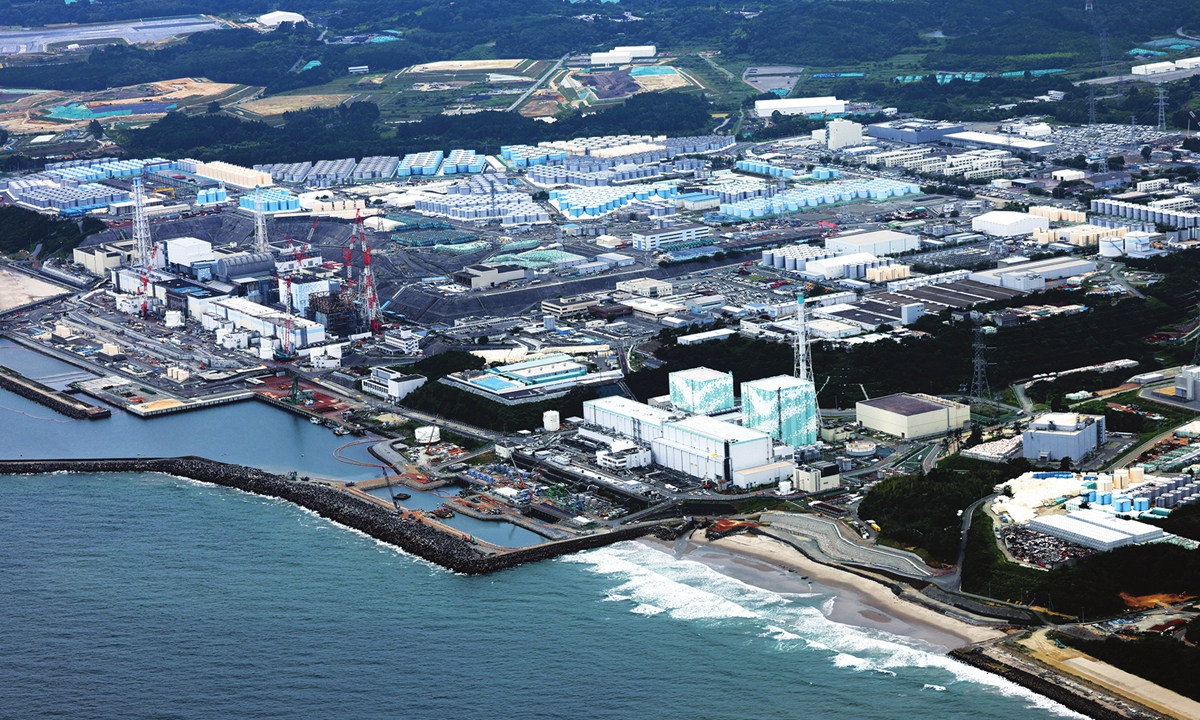
Tokyo Electric Power Co (TEPCO) Fukushima Daiichi nuclear power plant. Photo: VCG
GT: The risks sound alarming, but are Western people genuinely concerned? We rarely hear strong opposition from Western countries. Surprisingly, even a multilateral organization like the IAEA has given Japan's release plan a green light. Why?Gao: The US openly supports the decision. More recently, the government of South Korea changed its original position of strong opposition to a kind of support. Over the last two years or so, Western governments, including media and academicians, have remained surprisingly silent on the issue.
This stands in stark contrast to the backdrop of the international environmental movement and legislation. I think this demonstrates clearly the West's hypocrisy, low moral standing, and double standards surrounding the issue of international ocean governance and international affairs.
Regarding the IAEA's final report, from the very beginning, my view has been that the IAEA is not a competent agency for ocean governance at all. At most, it is a side agency in this issue. The competent agencies for ocean governance include, among others, the International Maritime Organization (IMO) and the International Tribunal for the Law of the Sea (ITLOS). The UN General Assembly and Security Council also play significant roles in this context.
The IAEA has no mandate whatsoever to issue a green light for Japan's discharge of contaminated nuclear water. What the IAEA can do is to set up the scientific standards, request compliance with those standards and monitor whether they have been followed or not by its member states.
Ruff: In some ways, my first response is, I don't care what the Western view is. This is a universal, global issue. It doesn't matter what one particular section of the world thinks about this.
It's important to acknowledge that the UN has many different agencies with different mandates. While the IAEA has given its stamp of approval to this discharge, I find it somewhat deceptive and dishonest, considering the structurally and institutionally conflicted mandate of the IAEA. It is, in its charter, a promoter of peaceful uses of nuclear energy, it's also the regulator of those materials. At the same time, it's the salesman as well as the police. It's an intrinsically and structurally conflicted role, and those two roles often do conflict.
In his report and public statements, Rafael Mariano Grossi, the director general of IAEA, says that this report is not a recommendation or an endorsement for the Japanese plan. But for any ordinary person looking at this, the huge fanfare surrounding Grossi traveling to Japan in a highly televised meeting with Prime Minister Kishida, the handover of the report, amount to a very powerful endorsement of this plan. There's no way to avoid that perception.
But if you look elsewhere in the UN system at institutions with different mandates, for example, the UN human rights council, then there have been no less than five special human rights rapporteurs with different responsibilities in health, food, the rights of indigenous people and in the management of toxic waste, who have come out very strongly against this plan to discharge water into the Pacific.
The Pacific Islands Forum established an independent scientific expert panel that has made very clear and strong recommendations that this discharge has not been proven to be safe and should not proceed. And the better alternatives that avoid trans-boundary and trans-generational pollution haven't been adequately considered. Those voices are very clear.
The US National Association of Marine Laboratories, of the more than 100 marine scientific laboratories across the US, have unanimously endorsed a statement critical of this discharge. So I think that there is international concern, but for a range of reasons, it may not have been very clearly expressed in large, proactive ways, particularly in the mainstream media.
Burch: Dominant standards focus on questions of chemistry and external radiation dose response. Based on my own research, those are not enough to answer the questions that really matter to frontline communities that are expected to eat, drink, breathe and live alongside these radio nuclei, whether it's in the fresh aftermath of a nuclear disaster, or it's this wastewater that's being in contact with melted down nuclear reactors inside of these nuclear fuel rods.
I studied the aftermath of the nuclear disaster from the inside of Japan. The Japanese government and TEPCO have been really successful at shutting down public deliberation about people's concerns and radio nucleus.
When anyone tries to ask a question like "are these dominant threshold limits ok?" or "are the standards ok?" When they start talking about this, they can get shut down in many ways.
We need to find a way to have an open discussion. I hope we can get to a discussion with the public and scientists and make sure that any standards that we have are reflective of the most up-to-date scientific findings.
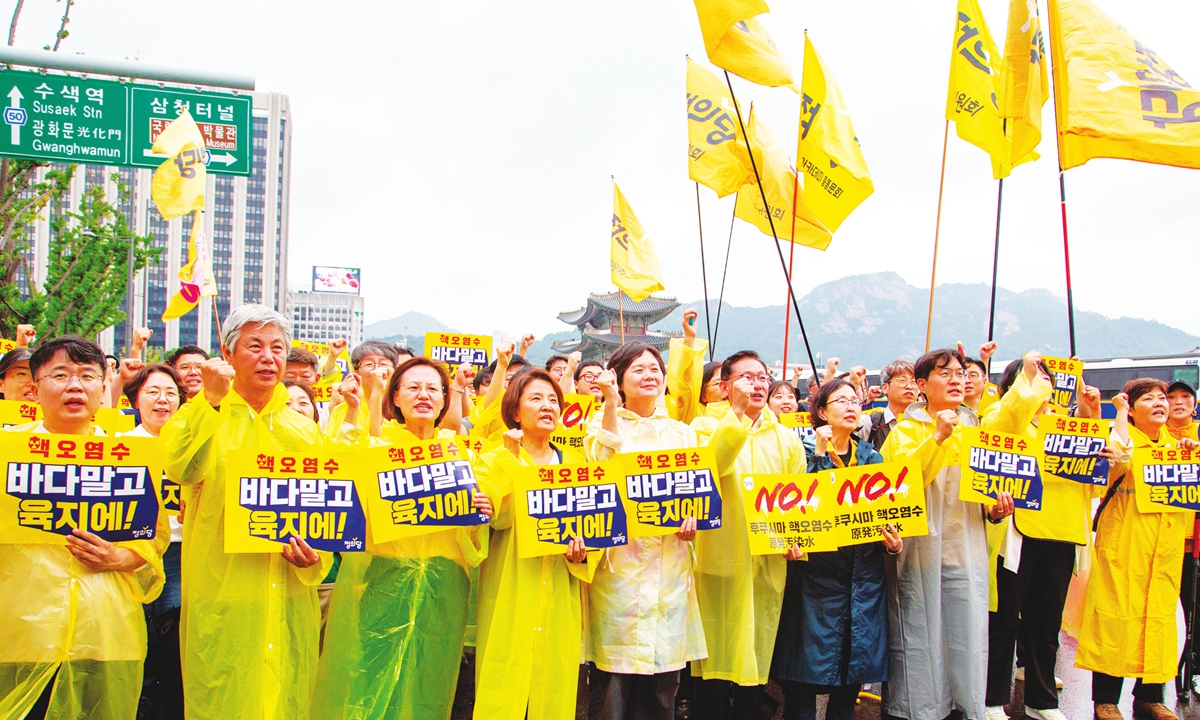
People in Seoul, South Korea, participate in a protest against Japan's plan to dump nuclear-contaminated wastewater on July 15, 2023. Photo: VCG
GT: Do you think discharging contaminated water into the Pacific would be a violation of human rights, as it deprives people of their most basic human need - to live in a healthy environment?
Burch: It's important that we situate this plan within a wider history of what has been going on since the beginning of the nuclear era. There are a lot of sociologists and social scientists who have been writing about this idea of nuclear colonialism.
It's a definition from (US scholar) Danielle Endres who describes it as the targeting of indigenous peoples and their lands and waters to sustain nuclear production processes. It's important not to separate the peaceful and the military nuclear technologies, because they often share the same infrastructures, be it uranium mines or waste dumping sites.
There has been a long history of targeting of indigenous peoples or their lands, waters and bodies that can be used as the waste sinks to sustain the nuclear industry. There's an assumption that you can cause all the kind of nuclear pollution you want through detonating a nuclear weapon in the Pacific, but you don't have to be legally accountable.
We have to go back to the history of Pacific Islands. That's where nuclear weapons have been detonated by the US, France and the UK. That has to be the first place we look at when we're thinking about human rights because there have been so many people, particularly in the Pacific, who have been targeted.
We really need to be listening to their voices. People in the Pacific are saying no and that there's no amount of scientific proof that should be used to override their sovereignty and self-determination, especially when the standards are not able to answer the questions that really matter to them.
Ruff: This approach of simply dumping material, which will spread freely with ocean currents and organisms, like fish, birds and sea mammals... puts it essentially out of mind and out of the jurisdiction of those responsible. It is a really antiquated, inappropriate and colonial response to waste management. Whether it contravenes the conventions that we have on the dumping of wastes in the ocean, this issue has been raised by a number of countries and people as to whether this actually constitutes a basis for a legal challenge.
This is not normal discharge. This is waste material that's projected to be discharged over many decades, which will continue to accumulate. We're not just dealing with the almost 1.4 million tons of contaminated water that's present now, some of which has already leaked into the ground water and will end up in the ocean, but many more tons that will accumulate over decades.
There's also a huge history of a loss of trust in the institutions in Japan, the government, TEPCO, the regulators, in their management and response to the whole ongoing Fukushima nuclear disaster.
Now Japan continues to have a 20-fold increase in the maximum permissible level of additional radiation exposure for an ordinary citizen. 12 years after the disaster, there is still no plan and timeline to reduce that level. The radiation protection standards which are applied currently in Japan, even to its most vulnerable citizens, young children, particularly girls, and pregnant women, are much higher than the standards operating in any other part of the world.
This is particularly a human rights issue when effective alternatives have been advocated by a variety of expert groups. Long-term storage of the water, or using the treated water in structural concrete applications where there is little or minimal exposure to people and the environment in foundations of buildings, under roadways and bridges, in tsunami barriers, haven't been adequately explored.
Gao: I also think that the final report and statement made by the chief of IAEA are self-contradictory and highly controversial. The director general stated that the treated water was drinkable and swimmable. That is surprising. If the water after treatment is safe, as he said, and can be used as drinking water and be used for swimming pools, why doesn't Japan use this water for its domestic agriculture and industrial purposes? If it's clean and safe enough, there was no need to discharge it into the oceans.
There are competent agencies on this matter. Let's talk about the UN Convention on the Law of the Sea. Japan is a party of this convention. Part 12 of this Convention is entitled, "Protection and Preservation of the Marine Environment." Article 192 imposes a general application on all the parties, including Japan, as a signatory state, has the obligation to protect and preserve the marine environment. Article 195 provides a duty not to transfer damages and hazardous from one area into another or transfer one type of pollution into another. This is a more specific international treaty application. I think Japanese decision and subsequent moves violates Japan's international obligation under the UN Convention on the Law of the Sea, not only the two articles, but nearly all the articles in Part 12.
GT: Some observers have suggested that governments could take the case to the International Tribunal for the Law of the Sea (ITLOS) against Japan. How could we proceed with such a lawsuit?
Gao: It is not a frequent proposal made in international discussion - taking the case to the International Court of Justice (ICJ) or ITLOS, where I worked for almost 14 years as a member of that tribunal. International litigation, like domestic legal procedures, is the last resort and the last final protection to preserve peace and justice in international affairs and international relations. It's an option. The option contains a number of procedures.
Take ITLOS, for example, at least we could take following procedures into consideration. To start with, there is a binding compulsory legal procedure, along with an advisory opinion. Both the ICJ and ITLOS have procedures for advisory opinions. Following this, there is a provisional measures procedure. We present the case to the tribunal and ask the tribunal to make a decision in terms of provisional measures. Finally, for ITLOS, there are Annex VII arbitral procedures.
Apart from the formal legal procedures, we could also take the case to the UN General Assembly. China, New Zealand, Australia, and other Pacific island countries could ask the general assembly to pass a resolution on the very issue of the Japanese decision of dumping nuclear-contaminated water into the oceans. I am personally optimistic in terms of a general assembly resolution.
About two years ago, I wrote an article published in the Global Times. I made a concrete proposal, BDI, Better Discharge Initiative. The BDI, as I proposed, is a regional and global roundtable mechanism. It can offer a different path, a political path, to address the issue of international cooperation in the scientific disposal of these contaminated waters. I think the BDI still remains a viable option for not only China and its neighboring countries but perhaps also New Zealand and Australia.
Ruff: Perhaps two additional comments I would make. If the discharge begins, it could be quite soon, even as early as August. These discharges are projected to proceed over many decades, even if the discharge begins, that's not the end of the matter, and that shouldn't be the end of it. Preventive action would be much more desirable.
From a public health point of view, a preventive approach is really the key here. We should identify the problems, anticipate them, and avoid them, not simply monitor the results of a decision that's been made. Once material is coming out of a discharge pipe, it doesn't matter how well you monitor it. At that point, you can no longer prevent it from coming out of the pipe. The key is to act in a proactive, preventive fashion.
Burch: I was involved in a conference called Nuclear Connections Across Oceania last year. In November 2022, we convened a panel to discuss the wastewater issue, and had speakers from Japan, the Marshall Islands, Fiji, and New Zealand, including lawyer Duncan Currie. He was in dialogue with the South Korean government, because they were considering a legal option. Politically, things changed, but he was telling us about this option. So after our panel, we got together and wrote a statement. As part of our statement, we asked the New Zealand government to consider taking Japan to court, given the fact that New Zealand says it is a nuclear-free nation.
We do not have a nuclear energy industry. So we were hoping we could have this conversation, but that was very quickly shut down. One of the reasons was because of the trust in the IAEA and in their standards. This is another reason why I keep pointing to these standards and how the standards of the IAEA can answer some questions but not all the questions, particularly those that are of concern to people on the front lines. If the IAEA was really upholding its standards, it would have required Japan to openly tell us and illustrate that the benefits of the discharge were greater than the harms to countries beyond Japan's borders.
Keeping the dialogue open and thinking about how we can address this together is really important. We have a lot of international agreements, like the Treaty of Rarotonga, about how we want to care for the ocean and how we do not want to dump nuclear waste into the ocean. We have other options, and those are the ones that actually should be considered, not just dumping into the ocean. That shouldn't be an option anymore.
GT: What kind of evidence and materials will be needed if countries start to seek compensation, file a lawsuit, or seek a UN resolution over this case?
Gao: In both domestic and international environmental cases, collecting and presenting established evidence of damage has always been challenging.
However, I think there is still room for neighboring countries, concerned parties, and international community at large, to think about and prepare ourselves in terms of evidence collection. For instance, we should consider the loss of fishing grounds in the open seas, especially in the Pacific, as well as the loss of fishing grounds in waters under national jurisdiction. Additionally, we should account for the impact on job opportunities in the fishing industry, and the economic loss resulting from catching and exporting sea products.
GT: Are there other options available?
Burch: I was watching what was happening with questions of food in the aftermath of the onset of the nuclear disaster. What I did notice was that Japan was able to fight back against those kinds of bans. Some countries may not want to purchase the foods or may impose some kind of economic ban. Japan would categorize these actions as reputation damage or rumors, because the dominant standards said it was safe.
So I think it's really important that we keep having these open conversations about the standards, about what they can do, and about scientific questions that need to be asked.
Ruff: There have been two preventive measures that have been proposed, both by expert groups in Japan and also by the Pacific Islands Forum scientific panel. One option is the construction of large, purpose-built, seismically safe storage tanks. The tanks that are currently on the Fukushima side were very hastily assembled, bolted together, not properly welded, and have leaked repeatedly. So, proper, long-term, seismically safe, large tanks could be built.
A second alternative - the treated water can be used in concrete for structural applications where it has little contact with people and the environment. And even if the concrete is subsequently broken up, the beta radiation, which is the main form of emission of radioactivity from tritium, doesn't penetrate very far. That's why it's harmful, damaging for people when you breathe it in or take it in through food and water. It's not so much a problem when it's outside your body because it doesn't penetrate the skin. Beta-emitting materials can be very effectively contained in concrete and release virtually none of the beta radiation from the concrete. That's the alternative that has been favored by the Pacific Island Forum expert group. And they've recently released a detailed paper advocating that and demonstrating the feasibility of that approach. And that, as far as I can establish and they can establish, has not been an alternative that has been thoroughly considered by TEPCO or the Japanese government.
I think it's important not to wait for evidence of harmful effects on people to take action, because scientifically, that is extremely difficult to do. Many of these impacts will be manifest only over many decades, and will put people at risk of developing because cancer, suffering from heart attacks and strokes. Things that are increased in risk by radiation are very common events; it is very difficult scientifically to discern a particular consequence of a particular event.
Radiation is harmful in all doses. The more you get, the more harmful it is. There's no threshold below which there is no effect. We should avoid exposures as much as possible and balance the harms and benefits. The harms are much greater with recent evidence than we previously understood. So we should look beyond historical standards that were decided in different contexts at different times.
The case should be made on the basis of harmful, unnecessary exposures that can readily be avoided. There certainly will be social and economic consequences, which are very likely to be measurable much earlier. As was mentioned, decline of fishing industry, income and exports, increased monitoring and restrictions on imports by a variety of countries are likely consequences that will certainly have measurable effects on fishing people in Japan. But it's pretty clear that from a Japanese point of view, they have not acted on the basis of local community and seafood industry concerns. Those concerns have been strongly and consistently put over many years and they have not held sway in Japan.
I think the argumentation really needs to be on the basis of this being an inappropriate approach. It contravenes the Law of the Sea, the London Dumping Convention and the spirit of the Treaty of Rarotonga (the South Pacific Nuclear Free Zone Treaty). The evidence is clear that this has harms widely and indiscriminately without commensurate benefits.
At the moment, we don't have any convincing evidence that the treatment of the water will work. Based on the evidence that TEPCO has released so far publicly, 72 percent of the samples of water that had been treated by APLS in one treatment round did not meet the regulatory standards. Some of them were almost 20,000 higher than the regulatory limit.
So we really have no proof that the purification system will work as intended. That's a very direct concern about this discharge. The one approach which the Japanese government is applying is dilution, as if somehow diluting the material, it obviously reduces the concentration. But the total amount of that material is unchanged. Dilution is not a solution, because it doesn't change affect the amount of material in total that is released at all.
